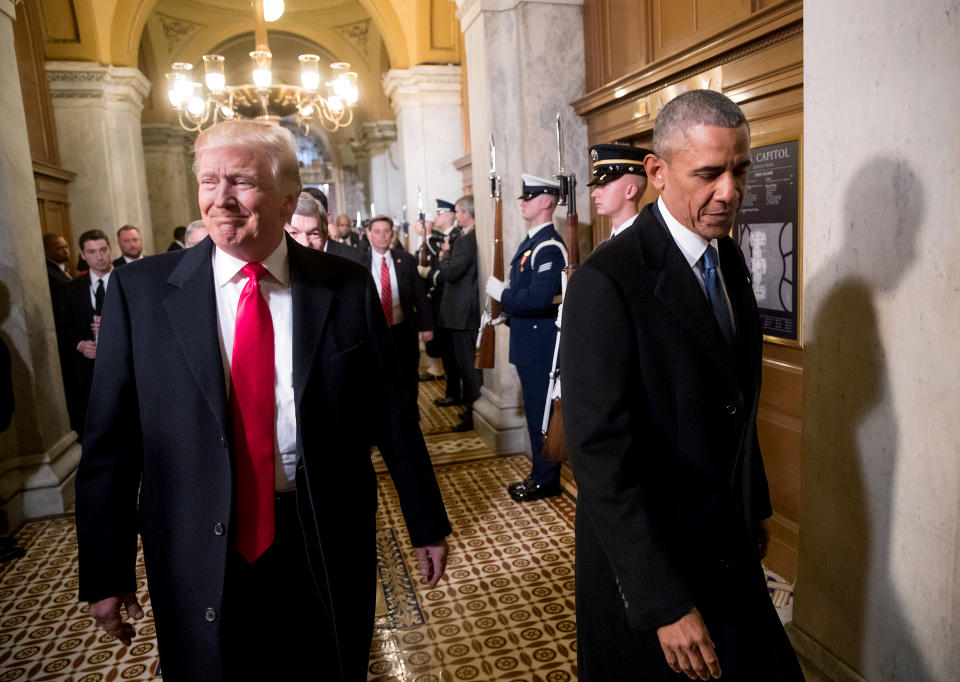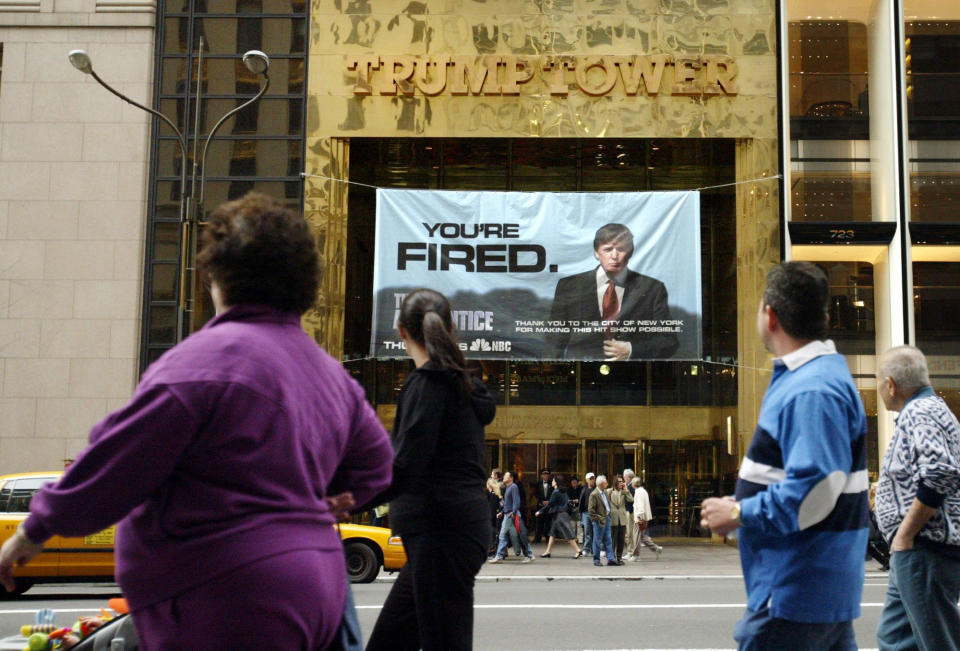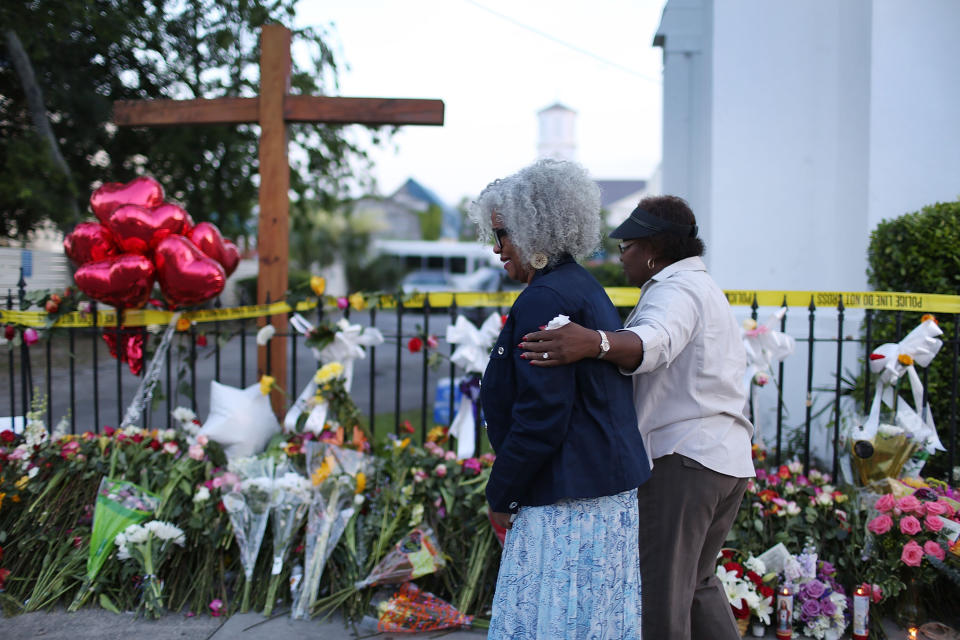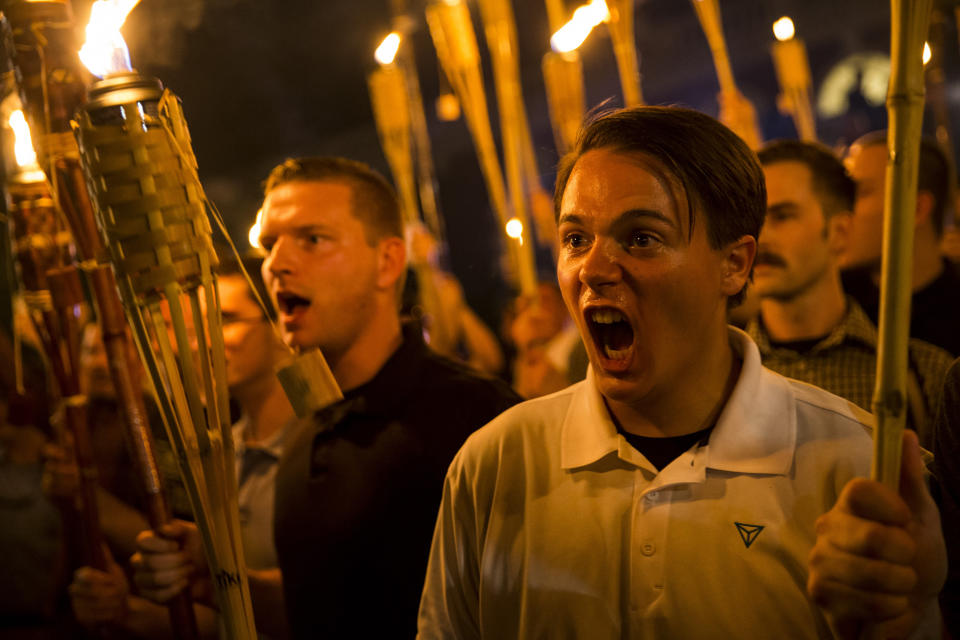There were many Americans who predicted Trump's policies would lead to violence
- Oops!Something went wrong.Please try again later.
To countless scholars, advocates and political actors, the violent mob that stormed the halls of Congress on Jan. 6 was not exactly surprising. To some, it wasn’t a matter of whether a mob inspired by Donald Trump would kick down the doors of the Capitol, but when.
“This situation, in this moment, for me feels something like the mythical Cassandra,” said Carol Anderson, author of the book “White Rage.” Anderson was referring to the character in Greek myth cursed with the gift of accurate prophecy that is not believed.
“I and many others, we have been hollering Trump is a racist,” she said. “Trump is a dangerous racist who stokes and speaks to those impulses in his most ardent followers. This isn’t economic anxiety that he appeals to, that he speaks to in his voters. It’s white supremacy. And, until this nation really deals with white supremacy and how dangerous we ought to know that it is, there will be another demagogue who eventually rises in his place.”
To Anderson and others, the warning signs have been clear all along.
“Why doesn’t he show his birth certificate?”
In March of 2011, Donald Trump sat in the middle of a long yellow couch, flanked by the co-hosts of ABC’s “The View.” The daytime gabfest was developing a reputation as a kind of key stop for those who want to test how well they and their ideas play to average Americans. And Trump, a celebrity with no policymaking experience, used his appearance to effectively lay out the terms on which he would run. The nation, three years into President Barack Obama’s first term, he said, was a mess, and had been “ripped off” by every country imaginable.
Then, he doubled down on the baseless conspiracy that he had been perpetuating throughout Obama’s rise.
“Why doesn’t he show his birth certificate?” said Trump, then the star of NBC’s “The Apprentice.” “If you are going to be the president of the United States,” the Constitution “says very profoundly that you have to be born in this country.”

The comedian Whoopi Goldberg pointed out that such demand would never be made of any white man who is president. The facts were already clear: Obama, born in Hawaii to an American mother, was always a natural-born citizen. But it didn’t matter. Trump’s insinuations spun a tale. They helped bolster a chorus whose primary argument was not consistent and rational disagreement with Obama’s policies but disdain for who Obama was and the very idea of someone like him occupying the White House.
To question Obama’s citizenship implied that he was ineligible to sit in the Oval Office. It also harked back to a time when Black Americans were also excluded from every benefit and feature of what it allegedly means to be American.
To someone like Nsé Ufot, a political organizer and CEO of the New Georgia Project, Trump’s so-called birtherism telegraphed a lust for clear white supremacy, waged through nationwide anger and division.
“It was the kind of disinformation I had seen in nations around the world,” Ufot said. “Today, the average government- or power-seeker knows that hot war is hella expensive — in the cost of lives and weapons and fighter planes. Countries are less and less inclined to spend in that way when you can destabilize a country by pushing disinformation and misinformation and attacking people's faith in institutions they need to be able to trust. We were on that in 2011, 2012 and for sure by 2014.”
Anti-Black resentment fueled a movement
By “on that” Ufot means Obama’s opponents were eagerly promoting birtherism, claims of massive voter fraud and a need for new voting restrictions, proven to disproportionately make it more difficult for Black, Latino and low-income Americans to vote. The worries expressed by conservatives about Obama’s origins and the threat of widespread voter fraud were, indeed, gaining traction.
“I don’t want to sound like Ms. Cleo or anything,” said Rashad Robinson, president of Color of Change, referring to the once ubiquitous television psychic. “But when I first got to Color of Change in 2011, the very first thing I tried to do was run a campaign against ‘The Apprentice.’” Robinson said it was clear then that Trump’s visibility on a popular show, where he “gets to play a smart, shrewd businessman,” helped him elsewhere perpetuate “dangerous racist tropes, unconscionable junk that would become the foundation of his abomination of a presidential campaign.”

When Robinson approached other potential allies with information to pressure “The Apprentice’s” advertisers to abandon the show, some were plainly dismissive. Others agreed birtherism was racist and even dangerous. But several asked Robinson if there were “more important” things to do, he recalled.
“When you think about the danger he posed almost a decade ago,” Robinson said, “the threat that Trump’s political résumé was essentially to push the Black man for his papers, the notion that this presidency would ever end with something besides a violent white mob is naïve.”
To Anderson, the fact that the Republican field of potential nominees in 2016 was full of political veterans who had succumbed to a political novice should have been a warning sign of the power and nature of Trump’s pull.
By choosing Trump and his birtherism, Republican voters chose a nominee who, to many, symbolized “a kilo of pure, uncut white supremacy,” Anderson said.
And over the course of his administration, Anderson said, Trump has distracted from crises and errors with inflammatory rhetoric or deeply divisive actions.
“You get Muslim bans, and ‘build the wall’ and ‘shut down the government,’” Anderson said. “You get a president willing to not fund the military’s paychecks so you can keep Confederate generals’ names on bases. You get calls for a ‘patriotic history’ that doesn’t include any of the ugly stuff. What’s the throughline? White supremacy. White supremacy makes people feel entitled to it all.”

Early pundits pointed to economic anxiety fueling Trump’s supporters, but this was only partially true. The average Trump voter in 2016 earned well above the national median income. What was predictive of Trump support: high levels of anti-Black sentiment, according to the National Election Survey, said Gabriel Lenz, a political psychologist at the University of California, Berkeley.
“Those who have said they were Trump voters because they like his tax policy, his judges, his description of himself as pro-life simply have to ask themselves if it was worth it and how they feel about the camp they are in,” said Anderson. “It includes a man who wore a ‘Camp Auschwitz’ T-shirt to take Capitol Hill.”
Black progress followed by rage and terror
In June 2015, when Trump descended Trump Tower’s gilded escalator, he acknowledged what people had speculated for years at that point: He was running for president. Then, Trump issued his notorious assessment of Mexican immigrants intermingled with his sense that America had, under Obama, become the laughingstock of the world. Trump promised he, and he alone, would make America great again.
“When Mexico sends its people, they're not sending their best,” Trump said that day. “They're sending people that have lots of problems, and they're bringing those problems with us. They're bringing drugs. They're bringing crime. They're rapists. And some, I assume, are good people.”
The day after Trump’s announcement, Dylann Roof, a white supremacist and misogynist, shot and killed nine people in a historic Black church in Charleston, South Carolina. The massacre cannot be linked directly to Trump, but Roof’s manifesto echoed some of the themes in Trump’s campaign announcement. In the document, which deplored America as a multicultural society where white men wrongly rank among the most disrespected and disadvantaged, Roof said he hoped his massacre would set off an active race war.
Some conservatives scrambled to recast the shooting as an attack on Christians instead of a race-based hate crime that took place at a Black church. Other observers who were willing to publicly connect the dots between Trump’s and Roof’s sentiments were dismissed or labeled ill-informed about American politics, said Anderson, a professor of African American Studies at Emory University.

A more accurate understanding of American politics would have to account for the repeated cycles of Black progress followed by broader white backlash, often punctuated and enforced by bloody events, Anderson said. It’s illustrated in the Jim Crow era and the terror of lynchings that followed the Civil War, the staunch segregation that followed Black involvement in World Wars I and II, and the assassinations that disrupted the civil rights movement’s major gains, said Thomas C. Holt, a history professor at the University of Chicago.
Holt said he can understand the collective shock as the nation watched the destructive mob force Congress into lockdown last week. But acts to commandeer the government — not petition or transform it — are not unprecedented.
“For all the sort of rah, rah, rah about American democracy, there have been a number of moments in American history where this same sort of call to violence we saw before the events at the Capitol, with the added element of the blind eye turned by public officials and no real consequences after the fact,” said Holt, author of the forthcoming book, “The Movement: The African American Struggle for Civil Rights.” “That’s also a pattern that colors the pages of the African American experience.”
Bloody, violent coups occurred across the American South during Reconstruction, forcing Black politicians from elected office and replacing them with white officials. In Wilmington, North Carolina, Black elected officials were rounded up in 1898 and given a choice: resign or die. Many of the white men involved in that coup and others like it around the South were or became mayors, governors, lawmakers, newspaper publishers and prominent businessmen.
“The excuses for not understanding that this is how American democracy has functioned relatively recently have worn thin,” Anderson said. “This stuff is within living memory.”
Throughout the 2016 campaign and the early years of the Trump administration, Trump encouraged his supporters to beat hecklers who had the temerity to protest at his rallies, offering to pay their legal fees. About one month before the election, Trump suggested that “Second Amendment people” could contain Hillary Clinton if she were elected.
Weeks after the election, when “hail Trump,” became a rallying cry at a white nationalist gathering held in Washington, Trump did not jump to distance himself.
By July 2017, Trump suggested publicly that police ought to be more aggressive and seek to intentionally beat up those arrested in connection with anti-Trump protests. For Anderson it all brought to mind white supremacist politicians in the Jim Crow era who encouraged or looked the other way at violence of the mob and law enforcement variety.

A month later, white nationalists descended on Charlottesville, Virginia, for a rally opposing a plan to remove or cover that city’s Confederate monuments. One counterprotester was killed when a white nationalist drove his car into a crowd. Several others were injured. Soon after, Trump made a comment that has defined his presidency: “You had some very bad people in that group, but you also had people that were very fine people, on both sides.”
“I think Charlottesville was horrifying,” said Lynda Garcia, the policing campaign director for the Leadership Conference on Civil and Human Rights.“That there was a show of domestic terror and the president sat there and didn’t condemn it, did nothing to stop it and did nothing to try to heal the country after an event like that.”
The unmissable warning sign, though, was that Trump had won over white nationalist support.
“It is deliberate and by design, and it is honestly frightening,” Garcia said.
Trump’s rhetoric had begun to create dangerous realities long before Charlottesville. In conversations with law enforcement across the country in 2015 and 2016, Garcia had been told that hate crime spikes seem to follow Trump rallies. A group of academics reached the same conclusion during the 2016 campaign.
In fact, during the Trump years, hate crimes reached record highs every year. That was true in 2017, in 2018 and in 2019.
“In many ways, Charlottesville also gets explained away,” Holt said. “‘Did he really mean that?’ The same ultimately has to be said of the abusive treatment at the border in ways that are just beyond the pale. All of these things indicate a moral compass that is just broken, and if you keep getting away with it you go further each time.”
About two months after the events in Charlottesville, a group of psychologists and mental health scholars broke with a long-standing practice among mental health professionals. They typically refuse to comment on the mental health of public officials and candidates. But, the group published a series of essays titled “The Dangerous Case of Donald Trump.” The words “sociopathy,” “incitements to violence,” and “malignant narcissist,” are not hard to find.
The rage and terror reach a crescendo
In the turmoil of 2020, protesters rallied in cities across the country challenging the repetitive cycle of police exercising extreme and deadly force on Black people and then walking away, often with minimal consequence. Trump insisted that the protests should be squelched with force, tear gas, tanks or other crisis-level tactics. He labeled those who engaged in looting “thugs,” and proclaimed, “When the looting starts, the shooting starts,” seemingly endorsing vigilante violence.
Yet in the protests, Trump and his campaign saw a rallying cause for his base, painting a picture of more protests and civil unrest if Joe Biden were elected, while Trump’s re-election would restore “law and order.” The concept relied heavily on a familiar refrain: the role of white fear of Black Americans, and any loss of influence and power.
When Trump lost the 2020 election, his focus shifted to questioning then, in more legal challenges and conversations with election officials, the role of voters in major cities. Trump’s ire and attention grew most intense around election results in cities with large Black populations who turned out in large numbers.
Then, Trump issued his final call to action to supporters galvanized by the idea that he had been robbed of the White House. As the rally progressed, one final panic button of sorts was pushed. Election returns from the Senate runoff in Georgia made clear Trump’s party had lost its edge in the Senate. Instead of returning two Republicans to the Senate, Georgia had elected two Democrats; a Black man raised in public housing and the Jewish son of an immigrant.

What’s notable, Robinson said, is that the mob that stormed the Capitol last week to engage in acts of domestic terrorism felt so emboldened, so empowered, so perfectly entitled to take over one of the nation’s most hallowed and secure buildings that they arrived with mostly bare faces.
It suggests they didn’t expect to be prosecuted but, rather, lionized.
Days after the attack, Sherrilyn Ifill, president and director-counsel of the NAACP Legal Defense and Education Fund, told MSNBC that the warnings that Trump and his politics were anathema to a multicultural democracy were made. The warnings were often ignored.
“There are many people… who also bear responsibility for what this nation has been brought to,” Ifill said. “They sit in newsrooms. The sit in C-suites of Fortune 500 companies. They sit in law offices. They sit in churches. They sit in the halls of Congress. They sit in statehouses. They are the people who have tolerated, condoned and in some instances supported, egged on and championed the thuggery of Donald Trump.
“They have been willing to allow our democracy to be debased in this way.”

